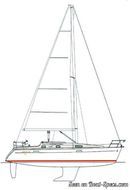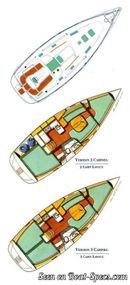Océanis 331 Fin keel
Sailboat specifications
The Océanis 331 is a 32’10” (10m) cruising sailboat designed by Finot Conq Architectes (France). She was built between 1999 and 2005 by Bénéteau (France) with 822 hulls completed. The Fin keel version features an L-shaped keel providing a good performance/price trade-off.
The Océanis 331 is as well listed, on Boat-Specs.com, in Keel and centerboard version (see all the versions compared).
The Océanis 331 is as well listed, on Boat-Specs.com, in Keel and centerboard version (see all the versions compared).
Océanis 331's main features
- Model
- Océanis 331
- Version
- Fin keel
- Hull type
- Monohull
- Category
- Cruising sailboat
- Sailboat builder
- Sailboat designer
- Sailboat range
- Country
- France
- Construction
- GRP (glass reinforced polyester):
- Hull: Single skin fiberglass polyester
- Deck: Sandwich balsa fiberglass polyester - Number of hulls built
- 822
- First built hull
- 1999
- Last built hull
- 2005
- Appendages
- Keel : fin with bulb
- Helm
- Single helm wheel
- Rudder
- Single spade rudder
- Unsinkable
- No
- Trailerable
- No
- EC design categoryiThe CE design category indicates the ability to cope with certain weather conditions (the sailboat is designed for these conditions)
A: Wind < force 9, Waves < 10m
B: Wind < force 8, Waves < 8m
C: Wind < force 6, Waves < 4m
D: Wind < force 4, Waves < 0,5m - A
- Standard public price ex. VAT (indicative only)
- N/A €
Océanis 331's main dimensions
- Overall length
- 34’ 2”10.41 m
- Hull length
- 32’ 10”10 m
- Waterline length
- 30’ 6”9.3 m
- Beam (width)
- 11’ 5”3.46 m
- Draft
- 5’ 5”1.66 m
- Light displacement (MLC)
- 11244 lb5100 kg
- Ballast weight
- 3527 lb1600 kg
- Ballast type
- Cast iron
- French customs tonnage
- 11.90 Tx
Océanis 331's rig and sails
- Upwind sail area
- 606 ft²56.3 m²
- Downwind sail area
- 1124 ft²104.4 m²
- Mainsail area
- 273 ft²25.4 m²
- Genoa area
- 333 ft²30.9 m²
- Symmetric spinnaker area
- 850 ft²79 m²
- IiFore triangle height (from mast foot to fore stay top attachment)
- 41’12.5 m
- JiFore triangle base (from mast foot to bottom of forestay)
- 12’ 4”3.76 m
- PiMainsail hoist measurement (from tack to head)
- 34’ 1”10.4 m
- EiMainsail foot measurement (from tack to clew)
- 14’4.28 m
- Rigging type
- Sloop Marconi masthead
- Mast configuration
- Deck stepped mast
- Rotating spars
- No
- Number of levels of spreaders
- 1
- Spreaders angle
- Swept-back
- Spars construction
- Aluminum spars
- Standing rigging
- 1x19 strand wire continuous
Océanis 331's performances
- Upwind sail area to displacementiThe ratio sail area to displacement is obtained by dividing the sail area by the boat's displaced volume to the power two-thirds.
The ratio sail area to displacement can be used to compare the relative sail plan of different sailboats no matter what their size.
Upwind: under 18 the ratio indicates a cruise oriented sailboat with limited performances especially in light wind, while over 25 it indicates a fast sailboat. - 205 ft²/T19 m²/T
- Downwind sail area to displacementiThe ratio sail area to displacement is obtained by dividing the sail area by the boat's displaced volume to the power two-thirds.
The ratio sail area to displacement can be used to compare the relative sail plan of different sailboats no matter what their size. - 379 ft²/T35.24 m²/T
- Displacement-length ratio (DLR)iThe Displacement Length Ratio (DLR) is a figure that points out the boat's weight compared to its waterline length. The DLR is obtained by dividing the boat's displacement in tons by the cube of one one-hundredth of the waterline length (in feet).
The DLR can be used to compare the relative mass of different sailboats no matter what their length:
a DLR less than 180 is indicative of a really light sailboat (race boat made for planning), while a DLR greater than 300 is indicative of a heavy cruising sailboat. - 180
- Ballast ratioiThe Ballast ratio is an indicator of stability; it is obtained by dividing the boat's displacement by the mass of the ballast. Since the stability depends also of the hull shapes and the position of the center of gravity, only the boats with similar ballast arrangements and hull shapes should be compared.
The higher the ballast ratio is, the greater is the stability. - 31 %
- Critical hull speediAs a ship moves in the water, it creates standing waves that oppose its movement. This effect increases dramatically the resistance when the boat reaches a speed-length ratio (speed-length ratio is the ratio between the speed in knots and the square root of the waterline length in feet) of about 1.2 (corresponding to a Froude Number of 0.35) . This very sharp rise in resistance, between speed-length ratio of 1.2 to 1.5, is insurmountable for heavy sailboats and so becomes an apparent barrier. This leads to the concept of "hull speed".
The hull speed is obtained by multiplying the square root of the waterline length (in feet) by 1.34. - 7.40 knots
Océanis 331's auxiliary engine
- Engine(s)
- 1 inboard engine
- Engine(s) power
- 30 HP
- Fuel type
- Diesel
- Fuel tank capacity
- 18.5 gal70 liters
Océanis 331's accommodations and layout
- Cockpit
- Closed aft cockpit
- Cabin(s) (min./max.)
- 2 / 3
- Berth(s) (min./max.)
- 4 / 8
- Head(s)
- 1
- Freshwater tank capacity
- 78.2 gal296 liters
- Fridge/ice-box capacity
- 39.6 gal150 liters
- Maximum headroom
- 6’ 4”1.92 m
- Galley headroom
- 6’ 2”1.9 m
- Head headroom
- 6’ 2”1.88 m
Océanis 331's saloon
- Maximum headroom
- 6’ 2”1.9 m
Océanis 331's fore cabin
- Maximum headroom
- 6’ 1”1.85 m
- Berth length
- 6’ 1”1.85 m
- Berth width
- 4’ 8”1.42 m
Océanis 331's aft cabin
- Maximum headroom
- 6’ 2”1.88 m
- Berth length
- 6’ 8”2.05 m
- Berth width
- 6’ 2”1.9 m
Similar sailboats that may interest you:
Sailboats
First built hull
Hull length
1987
30’ 4”9.25 m
1984
33’ 7”10.23 m
2007
30’ 6”9.3 m
2016
32’ 8”9.97 m
2016
36’ 6”11.13 m
1996
34’ 6”10.52 m
1983
30’ 2”9.2 m
2007
30’ 6”9.3 m
1997
31’ 2”9.5 m
2003
32’9.75 m
2014
32’ 8”9.97 m
1999
32’ 10”10 m
2013
32’ 8”9.97 m
1989
34’ 10”10.6 m
2003
32’9.75 m


